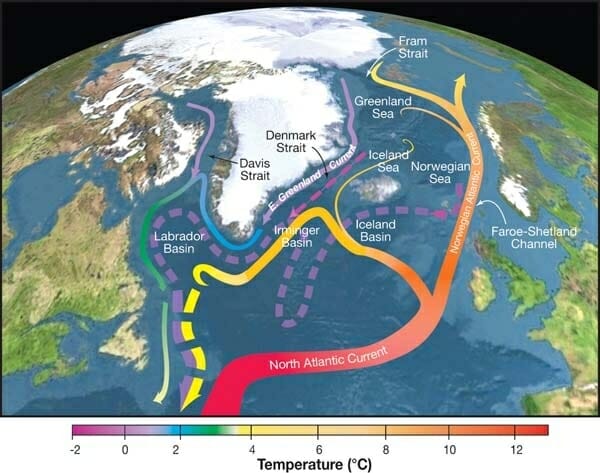Climate scientists have reported warning signs that indicate the collapse of the Gulf Stream. A study published on August 5 detects that the currents have reached “an almost complete loss of stability over the last century,” as the paper’s author, Niklas Boer, writes. This could indicate a near shutdown of the Gulf Stream.
The Gulf Stream is part of the Atlantic Meridional Overturning Circulation (AMOC), a major complex system of ocean currents that is driven by differences in temperature and salt content. The AMOC is critical in regulating the planet’s weather patterns as it transports warm, salty surface water from the tropics to the deep, cold water in the North Atlantic, which in turn is transported back southward.
The AMOC regulates everything from rainfalls in India, South America, and West Africa, to storms and temperatures in Europe and sea levels off the coast of America, impacting the Amazon Rainforest and the Antarctic ice sheets, too. Therefore, this system of ocean currents is critical to the balance of heat and energy distributed globally, which determines our weather patterns.
The AMOC can undertake two states: either a strong and fast state or a low and weak one. The study, which includes 150 years of datasets, according to the Guardian, observed that the AMOC is experiencing a gradual weakening. A trend that was already observed by 2018, where scientists found that the Atlantic current had reached its weakest point in 1,600 years.
The study found that the AMOC is no longer stable. It is now at a point of instability and close to a critical transition, due to the melting ice sheets of Greenland that releases freshwater, which plays a critical role in slowing down the AMOC as it interferes with the salinity of the oceans.
Consequently, the AMOC is considered to be at a critical tipping point – meaning the irreversible changes to the climate caused by global heating can have a domino-effect on other critical earth systems. For instance, another critical tipping point is the melting of ice sheets. “The Atlantic Meridional Overturning really is one of our planet’s key circulation systems,” Niklas Boers explained.

The AMOC tipping point can have serious consequences upon the worldwide weather patterns. It could cause extreme cold in Europe and North America, raise sea levels, endanger the Amazon Rainforest and the Antarctic ice sheets, and even disrupt monsoons that provide water to large parts of the world.
However, the danger is that, due to the complexity of the AMOC, scientists can’t predict the date of the collapse. The level of CO2 emissions that could trigger the fall of AMOC remains unknown. But one thing is certain, the collapse simply cannot be allowed to happen.
As reported by The Guardian, Niklas Boers explained, “the only thing to do is keep emissions as low as possible. The likelihood of this extremely high-impact event happening increases with every gram of CO2 that we put into the atmosphere.”
Passing the tipping point of the AMOC would be irreversible and have significant, life-altering ramifications.
Editor’s Note: The opinions expressed here by Impakter.com columnists or contributors are their own, not those of Impakter.com. — In the Featured Photo: Ice sheets in Greenland. Featured Photo Credit: Wikimedia Commons.










